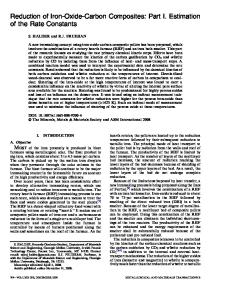Role of ore/carbon contact and direct reduction in the reduction of iron oxide by carbon
- PDF / 194,958 Bytes
- 2 Pages / 603.28 x 783.28 pts Page_size
- 25 Downloads / 426 Views
3FeO + CO
FeO + C--~ Fe + CO
[1] [2] [3]
or reduction through gaseous intermediates: 3Fe203 + CO ~ 2Fe304 3. C O 2
[4]
Fe304 3- CO ~ 3FeO + CO2
[5]
FeO + CO ~ Fe + CO2
[6]
Many workers have tried to study the kinetics of true direct reduction process by using mixtures of hematite and graphite t~j and wustite and graphite, t21 It is apparent that true direct reduction can only be studied when the gaseous products of reaction, namely, CO and CO2, are removed from the system as soon as they are produced. This can be done by either studying the system under high vacuum or with a high rate of flushing by an inert gas. Yun r~l carried out his experiments on direct reduction in the temperature range of 700 ~ to 1100 ~ using a vacuum of 5 • | 0 -4 torr. He concluded that diffusion of carbon through the reduced iron shell was the ratecontrolling step. Martin and Winard 12t studied reduction of synthetic wustite by graphite both under v a c u u m (10 -4 torr) as well as with a high rate of argon flushing
R. HAQUE, Professor, is with the Metallurgical Engineering Department, Bangladesh University of Engineering and Technology, Dhaka, Bangladesh. H.S. RAY, Director, is with Regional Research Laboratory, Bhubaneswar 751013, Orissa, India. Manuscript submitted December 17, 1993.
Table I.
(2.4 L/min). They concluded that the solution of carbon in the metallic phase was the rate-determining step of the process. It has now been accepted i3,4.51 that reduction of iron oxide in a blast furnace and also in the direct reduction processes producing sponge iron occurs mostly due to indirect reduction. Although attempts have been made to prevent solid-gas reactions by using vacuum or continuous inert gas purging, it is doubtful if one can prevent indirect reduction completely. Obviously, solidsolid reaction necessarily requires oxide-carbon contact. One may, therefore, be tempted to study the role of true direct reduction in terms of the solids contact only. This may, however, introduce a complication in the form of catalytic effect of metallized iron on the gasification reaction. The whole question has been re-examined critically in the present work by using separate layers of ore and reductant with or without physical contact using different forms of char and coal. Experiments have been carried out by studying the reaction of a bottom layer of reductant and a covering layer of iron ore using a fixed weight ratio, particle size, and temperature. While the layers were in actual contact in some experiments, in some other experiments they were separated by a thin stainless steel mesh. To study the possible catalytic effect, different forms of char with different reactivities were used. Some experiments were also carried out using coal as the reductant. The reduced mass was analyzed for total iron, and the degree of reduction (a) was calculated using the relationship suggested by Chernyshev e t a / . [61 and also by Gonzales and Jeffes. 171 The formula is written as = K
pct Fer - pct Fe~ pct Fer x pct Fe~
x 100
[7]
where K =
Data Loading...











